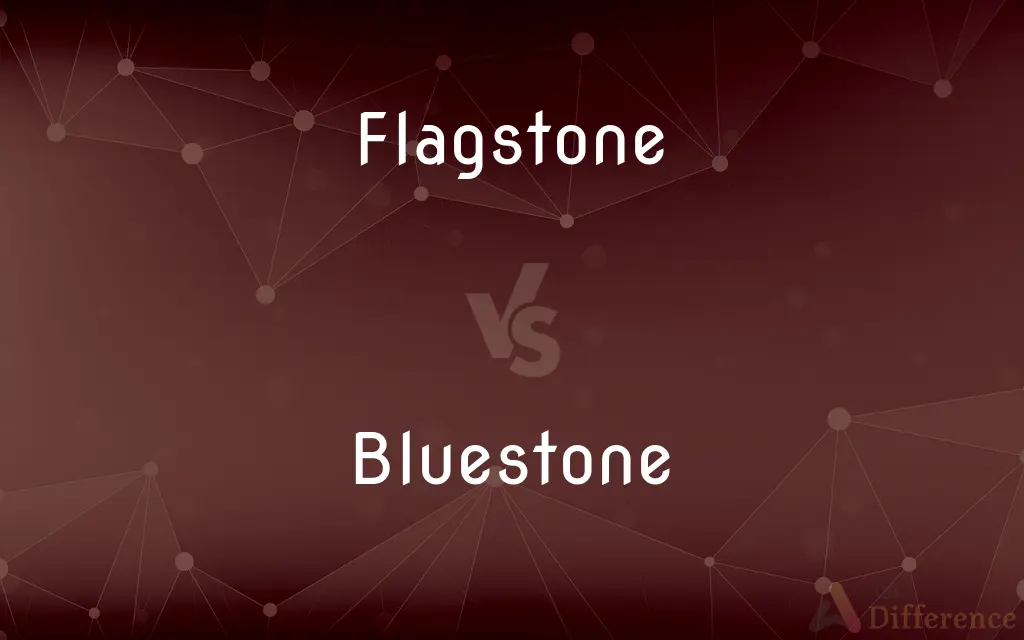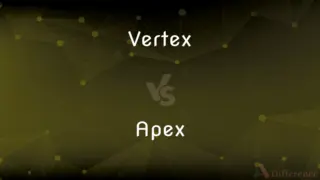Flagstone vs. Bluestone — What's the Difference?
By Urooj Arif & Fiza Rafique — Updated on April 23, 2024
Flagstone refers to various flat stones used for paving, displaying diverse colors and textures; bluestone specifically denotes sedimentary rocks with a blue-gray hue.

Difference Between Flagstone and Bluestone
Table of Contents
ADVERTISEMENT
Key Differences
Flagstone is a term used broadly for any type of flat stone suitable for paving, such as sandstone or limestone. Bluestone, on the other hand, typically refers to specific types of sedimentary rock, mainly found in the U.S., known for their distinctive blue-gray color.
Flagstone offers a variety of colors from red to blue to brown, depending on the minerals present in the rock. Bluestone, whereas, is prized for its consistent blue to gray shade which gives a more uniform appearance to projects.
Flagstone can vary greatly in thickness and durability, which makes it suitable for both formal and informal applications in landscaping. Bluestone is generally more uniform in thickness and is highly durable, making it ideal for high-traffic areas.
Flagstone pieces are typically irregular and vary in shape, which can create a rustic look. Bluestone is often cut into uniform rectangular or square shapes, providing a more formal aesthetic.
The texture of flagstone can be rough or smooth based on how it is finished; this variability adds a unique character to each piece. Bluestone tends to have a finer, more even texture, which can be slippery when wet but offers a sleek appearance.
ADVERTISEMENT
Comparison Chart
Type of rock
Various (sandstone, limestone, etc.)
Primarily sedimentary rocks
Color Variability
High variability (red, blue, brown, etc.)
Low variability (primarily blue to gray)
Shape and Size
Irregular shapes and variable sizes
Uniform shapes (rectangular, square)
Texture
Can be rough or smooth based on finish
Generally fine and even
Preferred Applications
Both formal and informal landscaping
Ideal for high-traffic and formal applications
Compare with Definitions
Flagstone
A type of flat stone used for paving.
The backyard was covered with flagstone, providing a natural look.
Bluestone
A dense, hard rock with a blue to gray color.
The patio was paved with smooth bluestone.
Flagstone
Can be split into thin layers.
The workers split the flagstone into thinner sheets for easier installation.
Bluestone
Often finished to enhance slip resistance.
The bluestone around the pool was treated to prevent slipping.
Flagstone
Varies in durability based on type.
The sandstone flagstone is less durable than granite.
Bluestone
Predominantly used in architectural and garden applications.
Bluestone steps lead to the garden for an elegant transition.
Flagstone
Used in both vertical and horizontal applications.
Flagstone was used for both the walkway and the retaining walls.
Bluestone
Sourced from specific regions, mainly in the northeast U.S.
The bluestone was shipped from an upstate New York quarry.
Flagstone
Often sourced from quarries.
The flagstone from the local quarry had a beautiful red hue.
Bluestone
Uniform in color and texture.
The bluestone tiles provided a uniform look to the facade.
Flagstone
Flagstone (flag) is a generic flat stone, sometimes cut in regular rectangular or square shape and usually used for paving slabs or walkways, patios, flooring, fences and roofing. It may be used for memorials, headstones, facades and other construction.
Bluestone
Bluestone is a cultural or commercial name for a number of dimension or building stone varieties, including:
Flagstone
A flat stone slab, typically rectangular or square, used for paving
A flagstone terrace
There was a carpet on the flagstones of the hall
Bluestone
Any of various bluish or grey building stones.
Flagstone
A flat slab of stone used as a paving material.
Bluestone
A bluish-gray sandstone used for paving and building.
Flagstone
An evenly layered sedimentary rock that can be split into paving stones.
Bluestone
A stone similar to this kind of sandstone.
Flagstone
A flat, rectangular piece of rock or stone used for paving or roofing.
Bluestone
Any of several bluish grey varieties of stone used for construction:
Flagstone
One of several types of rock easily split and suitable for making flagstones.
Bluestone
(UK) A form of dolerite which appears blue when wet or freshly broken.
Flagstone
A flat stone used in paving, or any rock which will split into such stones. See Flag, a stone.
Bluestone
(UK) Any of the several (massive) kinds of non-local stone (particularly dolerite) used to construct Stonehenge.
Flagstone
Stratified stone that splits into pieces suitable as paving stones
Bluestone
A feldspathic sandstone found in the US and Canada.
Bluestone
(US) A form of limestone found in the Shenandoah Valley and some other places.
Bluestone
A bluish grey basalt or olivine basalt.
Bluestone
Slate, such as comes from quarries in or near Adelaide.
Bluestone
Either of two related copper- and sulfur-based bright blue stones:
Bluestone
Copper(II) sulfate, CuSO4(H2O)x where x is 0-5, used as a coloring agent in glass-making and pottery and for other purposes.
Bluestone
Chalcanthite, a water-soluble sulfate mineral, CuSO4·5H2O.
Bluestone
Lapis lazuli, or its core constituent, lazurite.
Bluestone
Blue vitriol.
Bluestone
A grayish blue building stone, as that commonly used in the eastern United States.
Bluestone
Bluish-gray sandstone used for paving and building
Common Curiosities
What is bluestone made of?
Bluestone is made of dense sedimentary rock, typically sandstone or limestone, with a blue to gray color.
Is bluestone more expensive than flagstone?
Typically, bluestone can be more expensive due to its uniform color and durability.
How do I maintain flagstone paving?
Flagstone paving should be regularly cleaned and sealed to maintain its appearance and durability.
Can flagstone be used for driveways?
Yes, certain types of flagstone can be used for driveways, particularly those that are thicker and more durable.
What is flagstone used for?
Flagstone is used for paving, walkways, patios, and other outdoor surfaces.
Are there different colors of bluestone?
Bluestone is primarily available in shades of blue and gray, but slight variations can occur.
Does bluestone need to be sealed?
Yes, sealing bluestone can protect it from stains and weathering.
Is bluestone good for high-traffic areas?
Yes, due to its durability, bluestone is excellent for high-traffic areas.
Can bluestone be used indoors?
Yes, bluestone can be used indoors, especially in areas like bathrooms and kitchens where its durability and aesthetic are valued.
What tools are needed to install flagstone?
Tools such as a hammer, chisel, level, and mortar are typically needed to install flagstone.
What climates are suitable for flagstone?
Flagstone can be used in a variety of climates, though in freezing conditions, it should be sealed to prevent cracking.
What is the typical thickness of flagstone?
Flagstone thickness can vary, but it typically ranges from 1 to 3 inches.
How does weather affect bluestone?
Bluestone can withstand a range of weather conditions but may require sealing to prevent discoloration and water damage.
Can flagstone be painted?
Flagstone can be painted, but it is not common practice as it detracts from the natural look.
What is the typical thickness of bluestone?
Bluestone is usually around 2 inches thick, making it suitable for a variety of uses.
Share Your Discovery

Previous Comparison
Vertex vs. Apex
Next Comparison
Brinjal vs. EggplantAuthor Spotlight
Written by
Urooj ArifUrooj is a skilled content writer at Ask Difference, known for her exceptional ability to simplify complex topics into engaging and informative content. With a passion for research and a flair for clear, concise writing, she consistently delivers articles that resonate with our diverse audience.
Co-written by
Fiza RafiqueFiza Rafique is a skilled content writer at AskDifference.com, where she meticulously refines and enhances written pieces. Drawing from her vast editorial expertise, Fiza ensures clarity, accuracy, and precision in every article. Passionate about language, she continually seeks to elevate the quality of content for readers worldwide.
















































